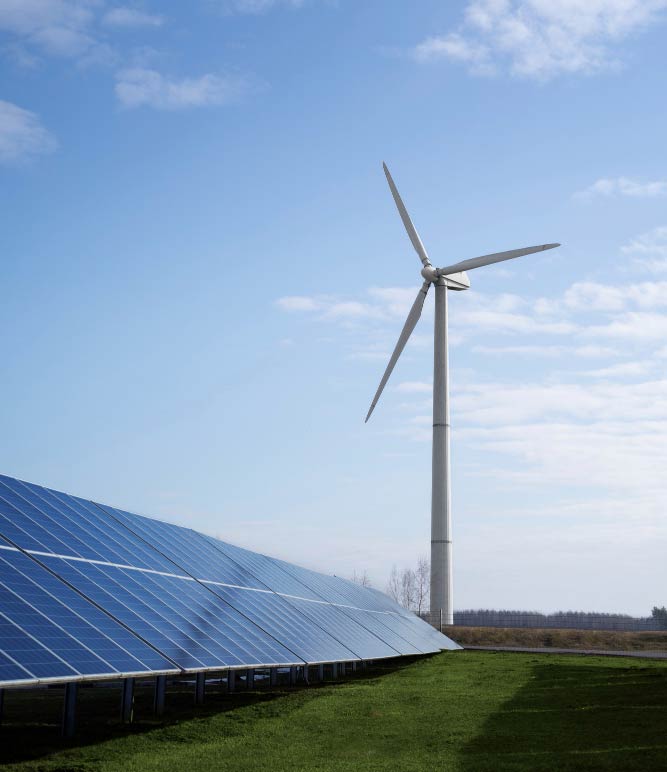Sun, wind, and a tight schedule, that is the rhythm on most renewable sites. Crews race the weather, subcontractors share the same access roads, and inspectors want clean, predictable results. When brush crowds string roads or grass climbs into the frames, work slows and risks rise.
Heavy duty mulchers give you a single pass method that clears growth, leaves a protective cover, and keeps your build or maintenance program on time.
This page lays out the field routine our teams use when the job is a live solar array or a wind project spread across miles of ridge.

Renewable energy work looks simple from the road, wide fields and tall towers under an open sky. On the ground it is a different story. Crews thread equipment between closely spaced piles and tracker rows, protect buried cable routes, and keep dust out of sensitive components while the wind never stops and the sun bakes the surface. Every pass must control debris and vibration near steel frames, hold a strict cutting height to protect soils, and leave a clean finish that will not blow onto modules or drift across a turbine pad.
Operators juggle three pressures at once. First, minimal disturbance to soil. Many sites sit on light topsoil over hardpan, so a careless turn can rut the grade, break crust, and start erosion that travels toward drains and inverters. Second, zero contact with structures. Tracker posts, guy anchors, junction boxes, and fiber runs live exactly where a tired operator wants to pivot. Third, mixed vegetation heights. Short grasses hide saplings, cured thatch sits under green growth, and woody volunteer trees appear along fences and access roads after a single wet month. The head must cut clean through that mix without flinging chips into frames or knocking markers loose.
Add the calendar and the rules. Work windows bend around nesting periods, storm seasons, and high fire weather. Wind limits how close you can operate beside modules because a gust can lift chips toward glass and seals. Noise and dust limits near neighbors tighten the plan even more. Then there are practical complications no map shows, shallow conduits at a crossing, an unmarked drain, a crane path that now carries service trucks.
A specialized approach keeps production moving without drama. Use low ground pressure carriers, keep the door closed to control discharge near modules, and set a conservative cutting height that preserves root mats. Run two light passes rather than one heavy push where thatch and woody stems mix. Stage spare teeth and a torque tool to stop vibration before it starts. Walk the first block with the site lead, mark danger zones with paint, and agree on a simple pattern that moves trucks first, then rows, then pads. When crews respect these constraints, the site stays safe, the finish stays tidy, and power stays on.
In renewable energy projects, the wrong equipment choice can slow production, damage infrastructure, or push maintenance costs beyond budget. A solar farm may look like flat open ground from a drone shot, but on site it often hides shallow conduit trenches, cable markers, and grade transitions that demand a light footprint. Wind farms add their own complexity, with steep pad approaches, rocky shoulders, and access tracks that see heavy truck traffic. Every piece of machinery that enters these environments needs to be selected with both performance and restraint in mind.
For mulching in these settings, the carrier is the first decision. Low ground pressure tracked units reduce rutting and maintain grade integrity, which is critical for preventing erosion under panel arrays and along wind pad approaches. In rocky or uneven terrain, protective belly pans, reinforced undercarriage components, and balanced weight distribution safeguard the machine against impact damage. Lessons learned in rocky terrain mulching transfer directly here, helping crews avoid costly downtime from undercarriage strikes or rotor wear.
Attachment selection is just as important. A head that is too aggressive may cut faster but risks throwing debris toward sensitive equipment or chipping panel frames. On the other hand, an underpowered head can bog down in dense grass-thatch mixes, forcing multiple passes and increasing operating hours. Drawing from choosing the right attachment for vegetation type, operators should match tooth pattern, rotor speed, and cutting width to the dominant vegetation while accounting for obstacles and safety buffers.
When configured properly, the right carrier and attachment combination delivers the precision needed to operate safely under tight clearances, the durability to handle rocky edges and uneven grades, and the efficiency to meet project deadlines without sacrificing finish quality. The investment in site-specific setup pays back quickly in reduced rework, fewer repairs, and cleaner transitions between work zones.
Big sites reward simple, repeatable moves. The aim is to keep the rotor in a steady bite while the carrier rolls in straight lines, with clean turn pockets and a clear place for chips to fall. If you already map rows and pad approaches, you can turn that map into a driving script. The pattern ideas in strategic cutting patterns to improve land coverage transfer directly to solar tables and turbine pads, with a few tweaks for tight clearances and sensitive hardware. Think of the site as lanes, not patches, and keep the machine flowing.
Clear, straight patterns reduce overlap, cut idle time during turns, and keep the team in rhythm. Crews move together, the pad stays tidy, and productivity holds steady from first light to shut down.
Renewable sites mix energized hardware, tight clearances, glare, wind, and public interface. That blend demands crews who can keep a cool head and a steady hand. Start the day warm, not rushed, and bring the team through the same rhythm every shift.
Use the playbooks in pre operation checks before large scale mulching missions to set baselines for pressure, temperature, and control response, then layer on the electrical and access rules that are unique to arrays and turbines.
Keep the rule book close, align with OSHA and ANSI mulcher safety standards, and coach operators with the plain language routines in your operator guides so decisions stay simple in the field.
A good spotter is your second set of eyes and your early warning. Keep them outside the throw zone, give them authority to call stop, and agree on simple hand signals that match the radio calls. Record readings and notes the same way every day so small drifts show up before they turn into heat, chatter, or a near miss.
“Efficiency in renewable site preparation is not just about speed, it’s about maintaining precision under environmental and safety constraints.”
Renewable fields do not forgive guesswork. Panel rows and turbine pads ask for steady output, clean discharge, and calm controls across long runs. Performance tuning starts with the basics, drive ratio, pressure targets, rotor speed, and feed method.
Telematics closes the loop, turning numbers into simple choices the crew can act on. Set clear limits for temperature and case flow, log them the same way each shift, and you will feel the machine stay in its band from the first strip to the last corner.

Large arrays and turbine approaches reward smooth loading. Hold engine speed where pressure stays stable, then pace ground speed to the bite your teeth can handle. Reduce tight turns that spike draw, plan turn pockets before the row ends, and keep pass overlap consistent so the head is cutting, not re cutting. Treat idle like a cost line, and make it visible in the daily brief so operators trim the minutes that drift away between moves.
Run these habits for a week and you will see it in the numbers and in the way the head spins up after each turn. For a deeper playbook that turns small choices into real savings, use the methods in heavy duty mulcher fuel efficiency tips.
Heat, wind, frost, and glare change how the machine behaves. In summer, schedule short cleanouts before temperatures climb, keep screens tight, and watch trend rate rather than chasing a single peak.
In shoulder seasons, dew and light rain add weight to grass and brush, so shorten the bite and slow the first pass to hold rotor speed.
Winter brings thick oil and power loss until the system is truly warm, which means longer warm up, verified pressures at temperature, and gentler first cuts while seals and fans settle.
When deadlines push into cold mornings, follow the reliability rules in cold weather performance and power loss prevention tips so starts are clean and output stays predictable.

On renewable energy sites, heavy-duty mulchers are expected to work long hours without pause, often in dusty, abrasive conditions that test every seal, bearing, and moving part.
These machines are not just clearing vegetation, they are operating in an environment where fine particles can settle deep into components and heat can build faster than in shaded forest corridors.
Preventative care is not optional here, it is the difference between a machine that completes a project without incident and one that spends days waiting for repairs. Every hour of planned maintenance translates into hours saved on emergency breakdowns and costly downtime.
The pace and pressure of renewable site clearing can make it tempting to skip the small checks, but that is when minor issues become major failures. A disciplined inspection routine before and after every shift is the most effective way to catch wear or performance changes early.
Using structured tools like daily mulcher inspection checklists ensures operators work through each critical point systematically rather than relying on memory.
On renewable energy sites, heavy-duty mulchers are expected to work long hours without pause, often in dusty, abrasive conditions that test every seal, bearing, and moving part. These machines are not just clearing vegetation, they are operating in an environment where fine particles can settle deep into components and heat can build faster than in shaded forest corridors. Preventative care is not optional here, it is the difference between a machine that completes a project without incident and one that spends days waiting for repairs. Every hour of planned maintenance translates into hours saved on emergency breakdowns and costly downtime.
The pace and pressure of renewable site clearing can make it tempting to skip the small checks, but that is when minor issues become major failures. A disciplined inspection routine before and after every shift is the most effective way to catch wear or performance changes early. Using structured tools like daily mulcher inspection checklists ensures operators work through each critical point systematically rather than relying on memory.
Consistent documentation of these checks creates a maintenance history that supervisors can use to schedule part replacements ahead of failure, keeping the project on track and avoiding mid-season equipment swaps.
High-output work in open, dusty environments calls for more than standard service intervals. Insights from heavy duty mulcher durability: engineering secrets show that sealing, guarding, and cooling strategies directly influence machine lifespan. Protecting seals and bearings from abrasive intrusion preserves efficiency and reduces mechanical drag, while maintaining hydraulic integrity ensures that pressure remains within the optimal range for steady cutting.
By integrating these habits into the daily and weekly workflow, crews create a protective buffer around the machine’s most vulnerable systems.
Over time, this discipline extends service life, reduces repair costs, and ensures that the mulcher remains ready for consistent, high-quality output in even the most demanding renewable site environments.
Share a few details about your rows, pads, terrain, and constraints, and we will match your site to the right head, drive settings, and cutting pattern. A project lead will review your maps, confirm utilities, and outline staging, travel lines, exclusion zones, and cleanouts. You leave with a one page setup, a safety brief, and a maintenance checklist your crew can run without guesswork.
If you want practical help from people who run these jobs, start the conversation and we will build a clear, auditable plan that fits your ground and your season.
To provide the best experiences, we use technologies such as cookies to store and/or access device information. Consenting to these technologies will allow us to process data such as browsing behavior or unique IDs on this site. Failure to consent or withdrawing consent may adversely affect certain features and functions.